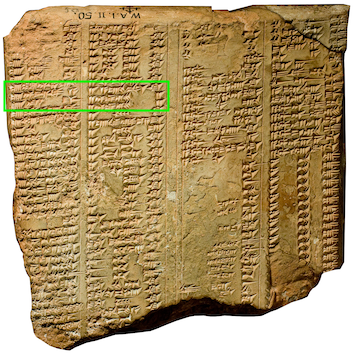Temples, Shrines, and Ziggurats of Agade

Reverse of K 02053a + K 04337, col. iv of which contains the "Kuyunjik Ziggurat List." The names of the three ziggurats at Agade are mentioned in col. iv 9–11. Image adapted from the CDLI.
Several first-millennium-BC lists of temples and ziggurats provide the Sumerian names of several religious structures at Agade, the capital of the Akkadian state founded by Sargon (r. 2334–2279 BC). According to the aforementioned texts, the principal buildings of that city — whose exact location is still unknown and debated among scholars, many of whom place it along or east of the Tigris River, between Samarra and Baghdad — were Eulmaš, the temple of its patron goddess Ištar; Eandasaya ("House Which Rivals Heaven"), the main ziggurat of Agade (presumably dedicated to Ištar); and the twin ziggurats of the god Dumuzi, Esugal ("House of the Great Niche") and Ebaraude ("House, Dais of Wonder"). According to inscriptions of the Neo-Babylonian king Nabonidus (r. 555–539 BC), Eulmaš, which might have been founded by Sargon's grandson Narām-Sîn (r. 2254–2218 BC), was rebuilt several times over its long history, including by two seventh-century-BC Assyrian kings.
Alphabetical list of temples at Agade
- Eandasaya: ziggurat
- Ebaraude: one of the twin ziggurats of the god Dumuzi
- Emegalamma: New Year's temple of the goddess Ištar
- Esugal(la): one of the twin ziggurats of the god Dumuzi
- Eulmaš: temple of the goddess Ištar
- E[...]mahdi: temple of the goddess Anunnitu
The Old Akkadian ruler Narām-Sîn claimed that he had a temple dedicated to himself built in his imperial capital. An Akkadian inscription incised on the base of a statue made of copper states:
Unlike Ištar's Eulmaš, that temple was abandoned, fell into ruins, and was forgotten after the collapse of the Dynasty of Akkad, which took place not long after the reign of Narām-Sîn's son Šar-kali-šarrī (r. 2217–2192 BC).
Jamie Novotny
Jamie Novotny, 'Temples, Shrines, and Ziggurats of Agade', Babylonian Temples and Monumental Architecture online (BTMAo), The BTMAo Project, a sub-project of MOCCI, [http://oracc.org/btmao/Agade/]